Essential Plants for Thriving Urban Gardens
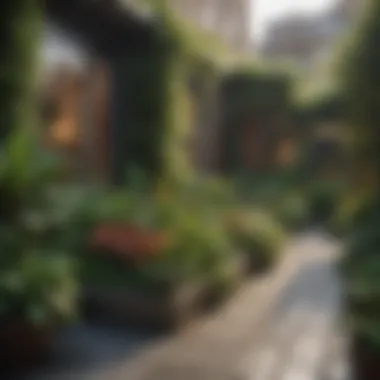

Intro
Urban gardening is becoming an increasingly relevant topic in today’s rapidly growing city landscapes. As more individuals find themselves living in high-rise apartments or tiny flats, creating green spaces has turned from a mere hobby into a necessary refuge for nature lovers. Not only do plants provide aesthetic value, they also serve crucial functions, such as improving air quality and enhancing mental well-being. This guide aims to unlock the secrets of choosing the right plants for urban environments, exploring their maintenance and integration into urban design.
Cities are often characterized by concrete jungles, where green spaces become a rarity. This underscores the importance of introducing adaptable flora that thrives in limited areas. Moreover, the psychological benefits of nurturing plants cannot be overstated. Tending to plants may offer a form of therapy — a way to unwind and escape from the daily grind.
"Urban gardening is not just about growing food; it's about cultivating a sense of community and connection among city dwellers."
In this series, we'll examine a variety of plants suitable for urban gardening, alongside practical tips for maximizing their potential in confined spaces. With a keen focus on biodiversity, we will also assess how these green companions contribute to more sustainable urban ecosystems.
Whether you’re a seasoned urban gardener or just dipping your toes into the green (or rather, green-thumb) waters, this comprehensive guide will provide valuable insights into thriving amidst the sprawl of steel and glass.
Understanding Urban Gardening
Urban gardening represents a lifeline for city dwellers, offering a connection to nature that can sometimes feel distant amidst towering skyscrapers and bustling streets. The act of cultivating plants in limited spaces opens the door to a world of benefits, filtering into our daily lives with a subtly fierce impact.
Definition and Purpose
At its core, urban gardening is the practice of growing plants in urban environments—be it in backyards, balconies, rooftops, or community plots. It's an approach that melds agricultural techniques with modern living. The purpose transcends mere aesthetics; it creates micro-ecosystems that foster biological diversity, enhance food security, and promote sustainability.
Urban gardening serves different communities—those yearning for fresh produce right at their doorstep, or individuals seeking respite from the urban chaos. People of all ages engage in these activities, learning hands-on skills, cultivating patience, and experiencing the palpable joy of watching a seed transform into a flourishing plant. The integration of greenery into city landscapes does not just beautify spaces but also enriches the culture of urban living.
Challenges in Urban Environments
However, diving into urban gardening is not all sunshine and daisies. The challenges faced are like a double-edged sword, sometimes making or breaking the gardener’s spirit. Limited space is perhaps the most conspicuous hurdle; every square inch counts when balancing your shopping bags with your potted herbs. Potential adverse soil quality also looms, with contaminants lurking in urban soils. Thus, it becomes essential to consider what plants will thrive and how much effort gardeners can realistically invest.
Furthermore, light availability varies drastically; shady nooks can restrict plant placement. In cities where air pollution is a constant companion, finding tools to ensure good air quality for both plants and people can prove tricky. With all these challenges, it becomes clear that effective urban gardening requires strategy, knowledge, and a bit of creativity.
Gardening in cities isn't merely about growing plants; it is a transformative way to reclaim public space, foster a sense of community, and build resilience against urbanization.
Navigating these aspects not only influences the success or failure of an urban garden but also frames the overall experience. Understanding the urban gardening landscape—its definitions, purposes, and challenges—sets the stage for exploring suitable plants and effective gardening methods in the sections to come.
Enthusiasts from diverse backgrounds, be they real estate enthusiasts, travel lovers, or interior design aficionados, will find not just information but also inspiration amid the pages of this guide.
Selecting Suitable Plants
Selecting the right plants is a cornerstone of successful urban gardening. Given the constraints posed by limited space, urban dwellers must consider several elements when choosing plants. These include the plants' growth habits, maintenance needs, and how they fit into their surrounding environment. The essence of urban gardening is not just about growing plants; it’s about crafting a thriving ecosystem amid concrete jungles. Choosing suitable plants can lead to enhanced air quality, improved aesthetics, and even edible outcomes.
Low-Maintenance Options
One of the biggest pulls for city gardeners is the allure of low-maintenance plants. For those knee-deep in schedules and city buzz, opting for hardy options saves both time and effort. Succulents and cacti are prime examples of such plants. They require minimal watering and care, making them perfect for busy urban lifestyles. Spider plants and pothos also thrive on neglect, and they have a knack for purifying indoor air. In container gardening especially, these plants can be beneficial, allowing for a green touch without the fuss. They are forgiving for beginners, making them ideal for any novice gardener just dipping their toes in the soil.
Edible Plants for Urban Spaces
The trend of growing edible plants in urban settings has sprouted up like weeds, and for good reason. Fresh herbs like basil, mint, and thyme can be grown easily in pots on balconies or windowsills. Imagine plucking fresh basil for your pasta right off your own plant! Vegetables such as cherry tomatoes and salad greens thrive in confined spaces and can adapt well to urban environments. Growing your own food not only champions sustainability but also offers the satisfaction of nurturing something that nourishes you. Plus, there's a certain thrill in knowing exactly where your food comes from.
Drought-Resistant Varieties
In urban areas where concrete heat traps moisture, drought-resistant plants offer an oasis of survival. Varieties like lavender and sedum not only endure tough conditions but also bring character to any garden. These plants need less water while still creating vibrant spaces. Ornamental grasses are another excellent choice. They have a unique way of swaying in the breeze, adding movement to gardens. By selecting drought-resistant flora, urban gardeners can contribute to water conservation efforts while still flaunting their gardening prowess.
Aesthetic Choices for Different Spaces
Urban gardening isn’t just about functionality; it's an artistic expression that enhances surroundings. If a small balcony or rooftop is what you have, consider statement plants like fiddle leaf figs or rhododendrons. These bring a pop of color and life to otherwise drab concrete. For vertical gardening options, climbing plants such as morning glory or clematis can transform walls into green canvases. Mixing and matching various shapes and colors can create a visually stunning and inviting atmosphere, regardless of space size.
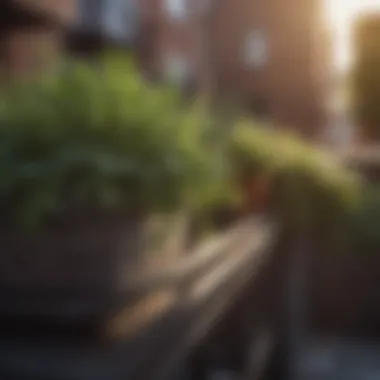
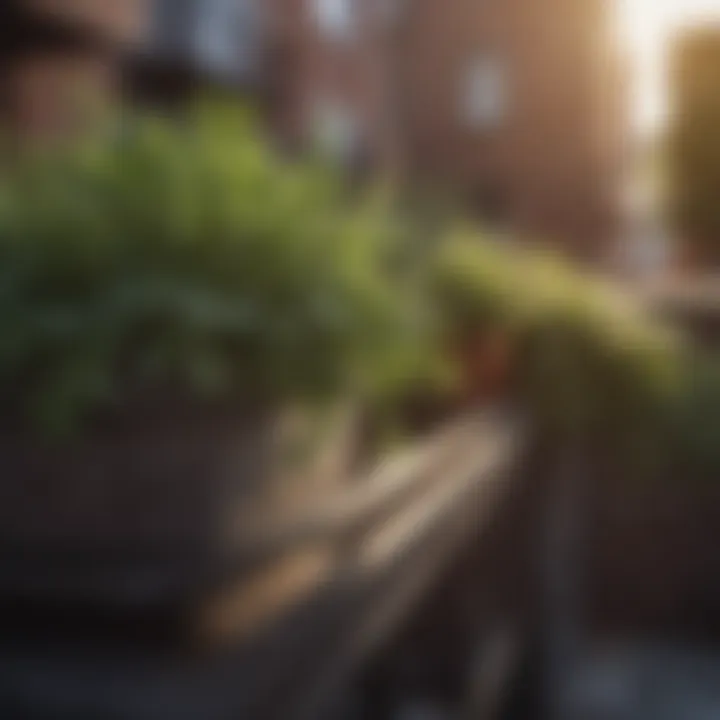
"Plants are not merely a decorative facet; they are the living heart of a diverse urban ecosystem."
By taking time to select plants tailored to their specific environments, urban gardeners can cultivate an oasis that’s not only practical but also beautiful. The right choice of plants directly influences not just the garden’s productivity but also the overall experience of urban life, reminding city dwellers of the profound connection to nature.
Methods of Urban Gardening
Urban gardening has taken root as a vital response to the challenges posed by city living. With diminished green spaces and the increasing need for sustainable practices, these methods allow urban dwellers to cultivate nature in their lives, enhancing both the aesthetics and the functionality of urban environments. Focusing on the various techniques available helps individuals maximize the use of limited real estate, fostering biodiversity while also addressing communal needs. The benefits of urban gardening go beyond personal gain, contributing to real environmental change in cities.
Container Gardening
Container gardening presents a fantastic opportunity for those short on space. Using pots or other containers allows for flexibility and creativity in the types of plants grown and their arrangement. You can set up a small garden on a balcony, patio or even a windowsill. This method proves particularly advantageous in urban settings where soil quality may be poor, as you can carefully select and manage what goes into each container.
Consider the following benefits of container gardening:
- Accessibility: Allows for gardening without a traditional garden plot.
- Mobility: Containers can be moved for optimal light or to keep them safe from harsh weather.
- Controlled Environment: Offers better control over soil, moisture, and nutrients.
However, there are considerations to keep in mind. You’ll need to invest in suitable soil mixes and ensure proper drainage in your pots. Thoughtful plant selection is key; certain species do much better in confined spaces than others. Herbs like basil, mint, and chives, or veggies such as cherry tomatoes and peppers tend to thrive in such setups.
Vertical Gardening Techniques
When vertical gardening comes into play, it transforms bare walls and fences into living canvases. This method involves growing plants upwards rather than outwards, making it an ideal solution for cramped urban environments. People can incorporate trellises, wall-mounted planters, and modular systems to leverage vertical space effectively.
The perks of vertical gardening include:
- Maximized Space: Allows for more plants in a smaller footprint.
- Enhanced Aesthetics: Adds beauty and interest to dull urban landscapes.
- Improved Air Quality: More plants can significantly contribute to better air quality, as they filter pollutants.
On the flip side, one must consider the structural support needed for installation and the specific care requirements the plants may have, especially regarding light and watering. Choosing hardy climbing plants like clematis or vines could expand your green space vertically without overwhelming your area.
Community Gardening Initiatives
Community gardening represents a collaborative and inclusive method that can uplift entire neighborhoods. These initiatives offer shared spaces for residents to grow flowers, herbs, or vegetables, thereby fostering community spirit and social interactions. Community gardens also serve as a common ground to engage with environmental education, gardening techniques, and sustainability discussions.
The importance of these projects is manifold:
- Social Cohesion: Brings people together, promoting community interaction and teamwork.
- Food Security: Helps alleviate food deserts by providing fresh produce to local residents.
- Education: Serves as a platform to teach sustainable practices and gardening skills to both children and adults.
Should you wish to get involved, local organizations and community boards often welcome newcomers to join existing gardens or start new initiatives. Social media platforms and community forums like Facebook or Reddit can be excellent resources for connecting with other gardening enthusiasts.
"Through shared efforts in community gardens, individuals can unite to transform urban landscapes, reflecting a stronger bond to nature and each other."
In essence, these methods not only allow you to cultivate your small slice of green in the concrete jungle but also connect with others and enrich both personal and communal lives. Understanding and applying these urban gardening methods can lead to a more sustainable, vibrant, and interconnected community.
Sustainability and Biodiversity
Sustainability and biodiversity play a crucial role in the context of urban gardening. With city landscapes constantly evolving, it becomes essential to ensure that the incorporation of green spaces fosters a healthier ecosystem. Urban gardening not only contributes to environmental conservation but also enhances the quality of life for urban dwellers.
When we dig deeper into the concept of sustainability, we realize that it's about using resources wisely and effectively. A sustainable urban garden practices include water conservation, waste reduction, and soil health management. Focusing on these practices can mitigate the negative impact of urbanization and help preserve the planet's resources for future generations.
Similarly, biodiversity is all about variety, a key aspect of sustainable gardening. By promoting a diverse range of plants, we can create ecosystems that are resilient and healthy. This diversity can act as a buffer against pests and diseases, reducing the need for chemical interventions.
"Urban gardens can act as biodiversity hotspots, offering habitats for various species and contributing to cleaner air and water."
Incorporating eco-friendly practices into urban gardening helps in conserving the biodiversity that urban areas often degrade. Native plants, in particular, play a significant role in this regard. They not only require less maintenance but also support local fauna such as birds and insects by providing food and shelter. This symbiotic relationship is vital for maintaining ecological balance.
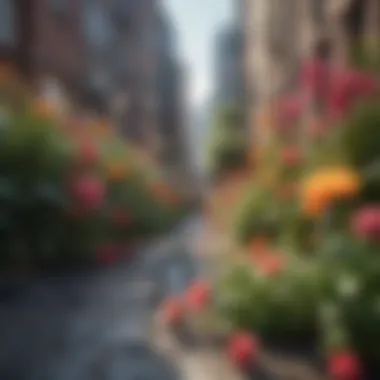

In summary, focusing on sustainability and biodiversity fosters healthier city environments, enhances urban aesthetics, and encourages a deeper connection with nature. Such approaches resonate well with real estate enthusiasts and interior design aficionados who value green living spaces.
Importance of Native Species
Native species are integral to successful urban gardening. They are well suited to the local climate, soil, and conditions, making them easier to cultivate and maintain compared to non-native plants. This adaptability results in lower water consumption, reduced fertilizer needs, and fewer pest problems.
Moreover, planting native species supports local wildlife, including pollinators, which are essential to food production and biodiversity. A garden filled with native plants can attract bees, butterflies, and birds, creating a vibrant ecosystem right in the heart of the city.
Here are key benefits of incorporating native species into urban gardens:
- Low Maintenance: Native plants are already adapted to local conditions, meaning they can thrive with less care.
- Support for Wildlife: They provide food and habitats for local fauna.
- Invasive Species Management: Native plants help prevent the spread of invasive species that could threaten local ecosystems.
- Soil Health: Their deep roots contribute to soil stability and health.
Choosing native plants not only benefits the environment but also creates a sense of place, connecting residents to the area they live in.
Pollinator-Friendly Plants
Creating pollinator-friendly gardens is an essential aspect of urban gardening that contributes to a nourished environment. Pollinators, like bees and butterflies, are crucial for the reproduction of many plants and are responsible for approximately one-third of the food we consume. By incorporating plants that attract these creatures, we can play a role in sustaining local ecosystems.
Targets for pollinators include plants like lavender, sunflowers, and coneflowers. These types not only beautify urban spaces but also offer vital resources for pollinators. Here’s why they matter:
- Food: They provide nectar and pollen, which are primary food sources for many pollinators.
- Habitat: Healthy, diverse plantings create natural shelter for various species.
- Educational Opportunities: Engaging in pollinator-friendly gardening raises awareness of environmental issues among city dwellers.
A successful way to promote biodiversity is to create garden designs that include blooms throughout the growing season. This ensures a continuous supply of food for pollinators and supports their lifecycle.
In essence, native plants and pollinator-friendly flora are pillars of sustainable urban gardening, which not only enhance aesthetics but also ensure the continuity of essential ecological processes.
Psychological and Environmental Benefits
Urban gardening is not just about beautifying concrete jungles; it can significantly contribute to mental well-being and enhance the environment. Connecting people with nature in a bustling city undoubtedly bears psychological advantages. By creating green spaces, urban gardeners can turn their little patches of land into havens of relaxation and rejuvenation, fostering a sense of community and belonging while simultaneously improving the surroundings.
Enhancing Mental Well-being
Engaging with plants provides a therapeutic respite from the relentless pace of city life. Various studies suggest that spending time in green spaces can reduce stress and anxiety levels. The simple act of tending to plants releases certain hormones like oxytocin, which might ease your worries, calms the mind, and boosts mood.
Incorporating greenery into daily life can be as easy as placing some potted plants on a balcony or nurturing a small vegetable garden. The ritual of caring for plants allows individuals to focus their attention, shifting their thoughts away from daily irritations. When people observe their plants growing and flourishing, it also instills a sense of accomplishment and purpose.
"Gardening is a way of showing that you believe in tomorrow." – Anonymous
From balcony herb gardens to vertical plant walls, the options are limited only by creativity. More importantly, incorporating plants into urban settings invites a variety of interactions, drawing neighbors together. Events like community gardening not only nurture plants but also relationships and friendships. Sharing experiences fosters a sense of togetherness, which positively influences emotional health.
Improving Air Quality
Plants are natural air purifiers, a crucial aspect of urban gardening that cannot be overstated. In city settings where pollution levels often run high, incorporating greenery acts as a buffer against harmful contaminants. Vegetation contributes to lowering particulate matter, ozone, and various volatile organic compounds in the air, making it cleaner and healthier for city dwellers.
From houseplants like spider plants to larger species like urban trees, each brings its own benefits. For instance, the peace lily is renowned for removing toxins like formaldehyde and benzene from indoor air, while outdoor trees can absorb carbon dioxide, releasing oxygen in the process.
Consider incorporating a variety of plants known for their air-cleansing abilities:
- Pothos: Effective at removing indoor pollutants.
- Snake Plant: Known for converting CO2 into oxygen at night.
- Rubber Plant: Great for reducing toxic substances indoors.
Creating more green spaces, such as community gardens or green roofs, can further facilitate cleaner air across neighborhoods. It's like creating tiny lungs for our cities, providing a necessary counterbalance to the bustling urban environment. Thus, urban gardening stands as a pillar that can substantially uplift both mental health and environmental quality.
Maintenance and Care
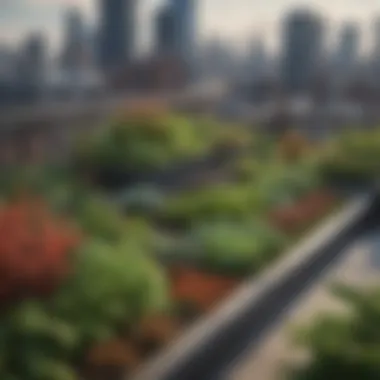
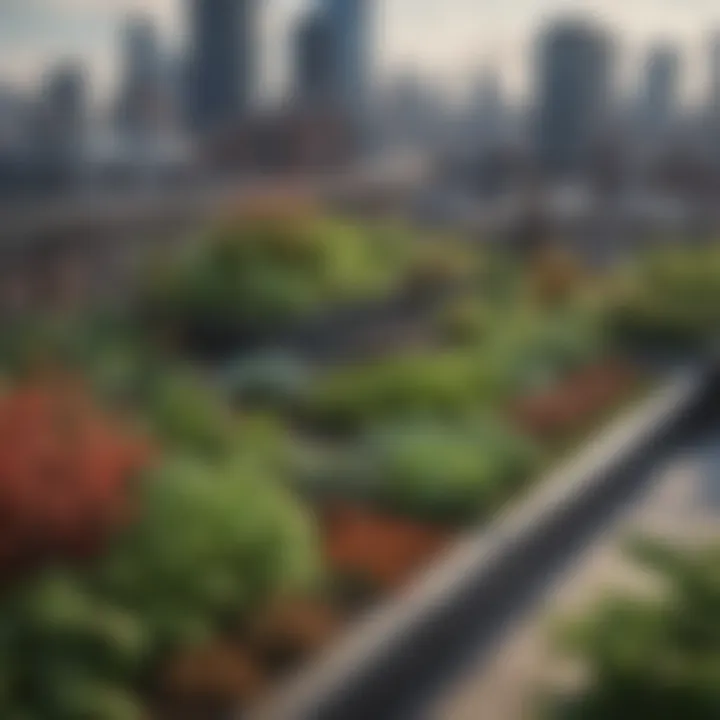
Urban gardening is not just about putting plants in pots or on rooftops; it requires a keen eye and a steady hand for maintenance and care. This is particularly crucial in urban environments where space is limited and conditions vary wildly. If you want your urban garden to thrive, understanding the nuances of plant care becomes essential. A well-maintained garden not only amplifies the aesthetics of your living environment but also promotes a healthy and sustainable ecosystem within the city.
Watering Techniques
Watering plants might seem as easy as filling a pot and pouring, but there’s much more to it. Different plants have unique needs depending on their species, growth stage, and the time of year. In a dense urban area, the microclimate can affect soil moisture levels, making it vital to understand the local conditions.
- Frequency: The key to effective watering is balance. Too much water can drown roots, while too little can lead to wilting and stress. Generally, it's a good practice to water your garden early in the morning or late in the evening to avoid evaporation.
- Method: Drip irrigation systems are highly effective in urban settings, minimizing waste and delivering water straight to the roots. If you prefer a manual approach, using a watering can with a long spout allows for precise watering, preventing oversaturation of the soil.
- Observation: Pay attention to your plants—be it drooping leaves or dry soil. These signals are nature’s way of telling you what’s the matter. Also, consider using a moisture meter for accurate readings, ensuring your plants receive just the right amount of hydration.
"The best garden is one where you listen to the plants, not just talk to them."
Soil and Fertility Management
Great plants flourish in great soil. Soil quality directly impacts plant health, growth speed, and resistance to pests and diseases. Urban soil often suffers from compaction and poor fertility due to heavy construction, so it’s essential to improve the soil’s structure and nutrient content.
- Testing Soil: Before planting, assess your soil’s pH level and nutrient composition. You can purchase an easy-to-use soil testing kit to gain insight into its current state.
- Amending Soil: Depending on the results, you might need to amend your soil. Adding organic compost improves both structure and fertility, enhancing the microbial activity necessary for plant growth. A mix of peat moss, vermiculite, or coconut coir can help retain moisture while allowing for aeration.
- Regular Maintenance: Fertilizing shouldn’t be a one-time deal. Use slow-release fertilizers or organic options to ensure a continuous supply of nutrients over time. Compaction can often happen in urban gardens due to foot traffic; aerating the soil periodically allows roots to breathe and flourish.
In summation, taking the time to care for your urban garden’s maintenance needs significantly contributes to its success. Proper watering techniques and a solid soil management plan form the bedrock upon which your urban garden will not just survive, but thrive.
Urban Gardening Trends
Urban gardening is evolving rapidly, influenced by technology, design, and environmental consciousness. These trends are pivotal for not just beautifying our cities but enhancing the quality of life and sustainability practices globally. Addressing the needs of urban populations, gardening has transformed from a simple leisure activity to a significant element in urban planning. Understanding these trends enables individuals and communities to harness the benefits of greenery in urban spaces, while also inspiring innovative gardening techniques.
Smart Gardening Technologies
Reflecting the marriage of nature and technology, smart gardening technologies serve as game-changers for urban gardeners. In the midst of high-rising buildings and limited spaces, these technologies simplify the complexities of gardening. Here are a few prominent tools making waves:
- Soil Sensors: These devices monitor moisture levels and nutrient content, providing real-time feedback to gardeners on when to water or fertilize, thus optimizing plant care.
- Automated Irrigation Systems: With just a tap on a smartphone, these systems ensure that plants receive the right amount of water, conserving resources and saving precious time.
- Grow Lights: Perfect for those lacking sufficient sunlight, these lights simulate natural daylight for indoor plants and can be programmed to cycle, creating a consistently optimal environment.
- Mobile Apps: Various applications assist in identifying plants, tracking growth, and even connecting with other urban gardeners, fostering a sense of community.
"The rise of smart gardening technologies transforms how urban dwellers interact with their green spaces, making gardening more accessible, efficient, and enjoyable."
Integrating these technologies into your gardening practice not only augments productivity but also aligns with a more sustainable approach toward urban agriculture.
Integration of Art and Gardening
The blending of art and gardening is a trend that resonates deeply with the aesthetics of urban living. As urban spaces become denser, the integration of creative elements into gardening practices has emerged as an essential form of expression.
Art can invigorate a garden atmosphere, making it not just a place for plants, but a canvas for creativity. Consider the following:
- Sculptures and Installations: Including art pieces within garden spaces adds character and can tell stories or convey themes, making the environment more engaging.
- Colorful Plant Arrangements: Mixing and matching plant varieties based on color schemes, shapes, and textures resembles an artist's palette, creating eye-catching visual arrangements.
- Vertical Art Gardens: These take vertical gardening to another level, where walls are adorned with murals or creative designs while hosting plants that scale upwards, blurring the lines between nature and art.
- Community Murals: In community gardens, collaborative artistic projects can unite neighbors, fostering a sense of community and pride in shared spaces.
Integrating art into urban gardening practices elevates the overall aesthetic and invites greater appreciation of nature. It fosters an emotional connection, turning repetitive tasks into a form of self-expression and creativity.
In summary, the trends in urban gardening reflect a shift towards smarter, more artistic, and holistic approaches to gardening in constrained urban landscapes. Understanding and embracing these trends not only equips individuals with the tools and knowledge necessary for successful gardening but also enhances the collective urban experience, making all city dwellers partners in cultivating greener, healthier environments.
Ending
Urban gardening is not just a passing trend; it embodies the vital integration of greenery into our urban landscapes. As cities continue to expand and evolve, the importance of plants in these environments cannot be overstated. They offer both aesthetic appeal and serve functional purposes, such as improving air quality and providing habitats for various species. The article highlights how thoughtful plant choices can make even the most confined spaces livelier and more breathable.
Understanding the future of urban gardening is paramount. It isn't merely about planting a few pots on a balcony or in a community garden. It is about reimagining our shared spaces, considering factors like sustainability, biodiversity, and mental well-being. As more people become aware of the environmental impacts of urbanization, the call for greener, more inclusive spaces grows louder.
The Future of Urban Gardening
As we look ahead, urban gardening will likely see significant transformations driven by various trends and technologies. Smart gardening technologies, like automated watering systems, will make caring for plants easier and more efficient. These innovations may take a lot of the guesswork out of watering schedules and nutrient management, allowing even the busiest city dwellers to enjoy the benefits of gardening.
Moreover, the integration of art and gardening represents a notable trend. Urban spaces are starting to feature vibrant murals alongside vertical gardens, blending aesthetic appeal with environmental benefits. This union of creativity and cultivation adds a unique charm to city settings, making it not just about gardening but creating visually stunning experiences.
"Urban gardening is not simply about growing plants; it’s about growing community and consciousness in our concrete jungles."
In addition, the emphasis on indigenous plant species in urban gardening encourages biodiversity. Planting native flora can attract local wildlife, establishing an ecosystem where plants, insects, and birds coexist sustainably. This helps restore some balance to disturbed environments while enhancing the ecological footprint of urban areas.
The future, as such, hinges on collective efforts to redefine how we garden in cities. It involves an evolving mindset that values not only beautification but also the essential connection plants forge between ourselves and the planet. As more urban dwellers take up gardening, future cities may blossom into greener havens that prioritize health, sustainabilty, and community well-being.







